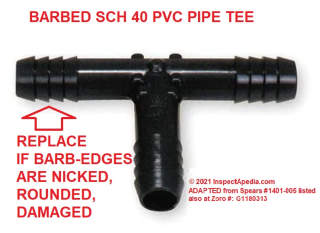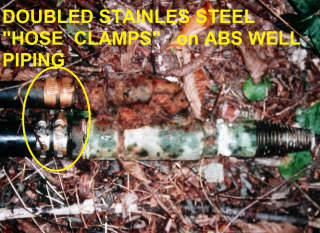 Hose or Pipe Clamp Leak Repair
Hose or Pipe Clamp Leak Repair
How to fix leaks at stainless steel hose clamps on pipes, tubing or ducts & vents
- POST a QUESTION or COMMENT about this article topic.
Leaks at plastic or rubber pipe, tubing, or hose fittings that are secured by a pipe or hose clamp can leak water out or air in, causing building water damage and on a well piping system, loss of pump prime.
Similarly, leaks may occur at flex duct or dryer vent ducts that are connected with larger stainless steel clamps.
This article describes the reasons that you may tighten a stainless steel hose clamp or pipe clamp without stopping a leak at that location: causes, emergency repair steps, preferred repair methods for plastic pipe or tubing leaks at clamp fittings.
InspectAPedia tolerates no conflicts of interest. We have no relationship with advertisers, products, or services discussed at this website.
- Daniel Friedman, Publisher/Editor/Author - See WHO ARE WE?
Cause & Cure for Leaks at Pipe Clamps or Hose Clamps
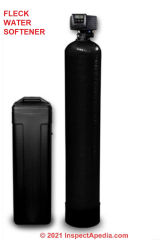 On 2021-06-22
by Ruth - should I stop a leak at a drain tee by adding a second drain line?
On 2021-06-22
by Ruth - should I stop a leak at a drain tee by adding a second drain line?
I can't seem to find the answer. I have a Fleck two tank resin water softener.
They have their own water line connected to the water pipe, separate digital meter, and electrical plug.
While in the drain, the person that installed it put a T-connection in the Softener Drain pipe.
So the two softener are connected. Even if I tighten the clamp, it still leaks.
Does two tank should have separate drain pipe?
at WATER SOFTENER BACKUP, FLOODING, LEAKS
On 2021-06-22 by inspectapedia.com.moderator (mod) - fix the plastic pipe or tubing leak, don't add more drain lines
@Ruth,
Thanks for asking a helpful water treatment equipment shared-drain question.
As long as the routing and diameter of the water softener (or other treatment equipment) drain is adequate to handle the total, combined, or maximum flow (for example if two devices are draining simultaneously) then sharing a drain is perfectly fine.
I would not like to solve a leaky T-connection problem by trying to hook up separate drains.
Rather I would fix the leak.
1. Be sure that the connections of plastic drain tubing or pipes on to the tee has fully-pushed the tubing over the ribbed surface of each of the tee connectors so that there is plenty of clamping space.
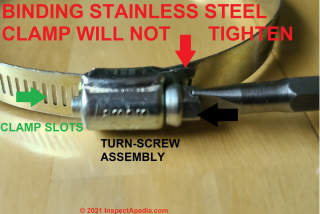
2. If tightening the screw of single steel hose clamps at each of the T-connections doesn't stop the leak, try loosening each clamp, sliding it inwards closer to the tee, thus making room to add a second parallel hose clamp.
Then tighten the two hose clamps snugly at each of the three legs of the tee.
Watch out: as we explain below, when tightening some steel hose clamps, particularly ones that are being re-used, the screw threads may bind in the slots of the steel clamp band. As you tighten against the binding area on the clamp band you think you're tightening against the tubing or hose and tee, but in fact you are not, you're tightening against a binding point in the clamp itself.
A binding point occurs in a stainless steel hose clamp if the screw threads are damaged, if the slots in the clamp are damaged, or if the clamp is bent where it is entering the screw fitting.
Sometimes you can tighten further past the binding point but a more-reliable measure is to remove and toss out the old stainless steel hose clamp and start with a new one. Or better, a pair of them.
I give more details of this hose clamp problem below.
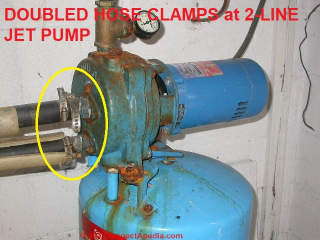
3. If doubling the clamps and snugging them up at each of the legs of the T-connector doesn't stop the leak it's time to install a new Bar bed Tubing T-connector like the one shown below.
And depending on the material, age, and condition of the hose, tubing, or pipes connected at the tee, it may be necessary to snip off a couple of inches from the end of each of those so that we are staring with both a new T-connector and also new tubing or piping ends.
I have particularly seen this problem with black ABS piping at well pipe connectors; in that case the ABS has to be heated to be shoved over the plastic connector male ends.
Re-heating the ABS to make repeated re-connections often leaves it brittle and so deformed that it won't seal well until the old ABS ends have been cut away.
Copper, brass, or stainless steel barbed fittings are a bit more resistant to rounding and damage of their barbed ridges but those fittings, too, can be damaged during installation or use and may need replacement if you can't stop a leak at such fittings by simply tightening the clamp.
Diagnose Failures at Stainless Steel Hose or Pipe Clamps
My photo above shows a stainless steel clamp I retrieved from my box of plumbing tools - I'm using a 4 1/2" diameter clothes dryer exhaust vent clamp - just because it was handy, but this observation pertains to ANY stainless steel clamp of this sort.
With the stainless steel band properly and squarely centered and entered into the screw-clamp or turn screw assembly (black arrow) I was able to get the clamp to feed under the screw and thus to tighten only about 3/8" before the clamp jammed completely (red arrow).
Even though the clamp appeared un-damaged (green arrow) it absolutely would not tighten further despite my strong turn of the screwdriver.
I un-screwed this "perfect-looking" clamp completely, pulling the lead-end out from the turn-screw assembly.
Surprise! This clamp had been used before, and its starting-end was damaged: bent out of a smooth curve radius, and at least one of the slots in the clamp was rough and gouged. The damage is a bit subtle but if you look closely at the second photo that I'll post you can see it.

Take a close look at my photo of the end of the clamp [just above] and you will see at least three types of damage:
- Two too-abrupt bends in the stainless steel strip - these can make it difficult for the turnscrew to pull the strip through the turnscrew clamp assembly
- Gouges across the thin metal strip between three of the slots in the stainless steel band, and
- A burr at the leading edge of the opening of the third band-slot.
These were preventing me from tightening the clamp past a certain point, giving a " false-tight " sense during clamp installation. The clamp was tightening against itself, not against the tubing or vent as was needed.
Watch out: you will never see this damage without completely-un-screwing the clamp assembly and inspecting it with care. The damaged portion is, when the clamp is assembled, completely hidden by the body of the turn screw assembly.
Best solution: Throw out this clamp and start with a new one.
In an emergency: open the clamp fully, and using a hammer and a flat hard metal surface, tap the clamp flat to remove any sharp bends, then use a steel file to file off any burrs; you may then be able to re-use the clamp provided that you can get the tightness that you need when an un-damaged section of the stainless steel strap is under the turn-screw.
...
Continue reading at PLASTIC PIPE LEAK CAUSES, or select a topic from the closely-related articles below, or see the complete ARTICLE INDEX.
Or see these
Recommended Articles
- LEAK CAUSES in WATER PIPING
- LEAK TYPES, WATER SUPPLY or DRAIN PIPES for help in finding leaks by understanding different types of leakage and when it occurs
- LEAKY PIPE REPAIRS
- PIPE / HOSE CLAMP LEAK REPAIR
- PIPING in BUILDINGS, CLOGS, LEAKS, TYPES - home
- PLASTIC PIPE LEAK CAUSES
- PLASTIC PIPING ABS CPVC PB PEX PPR PVC - home
- PUMP PRIME, REPEATED LOSS
- WATER SOFTENER BACKUP, FLOODING, LEAKS
- WELL PIPING LEAK DIAGNOSIS if your building water supply is provided by a private well
Suggested citation for this web page
PIPE / HOSE CLAMP LEAK REPAIR at InspectApedia.com - online encyclopedia of building & environmental inspection, testing, diagnosis, repair, & problem prevention advice.
Or see this
INDEX to RELATED ARTICLES: ARTICLE INDEX to PLUMBING SYSTEMS
Or use the SEARCH BOX found below to Ask a Question or Search InspectApedia
Ask a Question or Search InspectApedia
Try the search box just below, or if you prefer, post a question or comment in the Comments box below and we will respond promptly.
Search the InspectApedia website
Note: appearance of your Comment below may be delayed: if your comment contains an image, photograph, web link, or text that looks to the software as if it might be a web link, your posting will appear after it has been approved by a moderator. Apologies for the delay.
Only one image can be added per comment but you can post as many comments, and therefore images, as you like.
You will not receive a notification when a response to your question has been posted.
Please bookmark this page to make it easy for you to check back for our response.
IF above you see "Comment Form is loading comments..." then COMMENT BOX - countable.ca / bawkbox.com IS NOT WORKING.
In any case you are welcome to send an email directly to us at InspectApedia.com at editor@inspectApedia.com
We'll reply to you directly. Please help us help you by noting, in your email, the URL of the InspectApedia page where you wanted to comment.
Citations & References
In addition to any citations in the article above, a full list is available on request.
- Our recommended books about building & mechanical systems design, inspection, problem diagnosis, and repair, and about indoor environment and IAQ testing, diagnosis, and cleanup are at the InspectAPedia Bookstore. Also see our Book Reviews - InspectAPedia.
- In addition to citations & references found in this article, see the research citations given at the end of the related articles found at our suggested
CONTINUE READING or RECOMMENDED ARTICLES.
- Carson, Dunlop & Associates Ltd., 120 Carlton Street Suite 407, Toronto ON M5A 4K2. Tel: (416) 964-9415 1-800-268-7070 Email: info@carsondunlop.com. Alan Carson is a past president of ASHI, the American Society of Home Inspectors.
Thanks to Alan Carson and Bob Dunlop, for permission for InspectAPedia to use text excerpts from The HOME REFERENCE BOOK - the Encyclopedia of Homes and to use illustrations from The ILLUSTRATED HOME .
Carson Dunlop Associates provides extensive home inspection education and report writing material. In gratitude we provide links to tsome Carson Dunlop Associates products and services.


